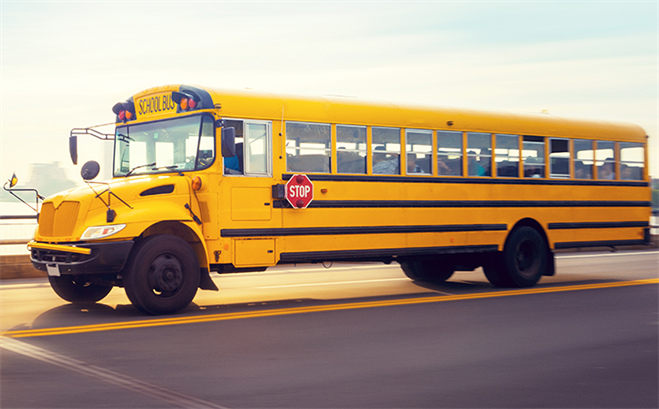K-12 Transportation Scalable Successes
August 02, 2021 by Meredith Trimble

In all parts of the country, school buses are revving into action once again. There is a cautious optimism for the start of a new school year with less disruption and more normalcy. This holds true for buses as well as classrooms.
During the height of the pandemic when schools were closed, districts from all regions leveraged student transportation technology to creatively serve their school families and communities. Two such districts won 2021 Tyler Excellence Awards for innovative use of transportation technologies by not only enhancing service during a crisis, but also holding great promise in continued use in a post-pandemic context.
Township High School District #214, Arlington Heights, Illinois
Prior to the onset of the coronavirus pandemic, District 214 offered its students a rich array of opportunities to access local college classes, internships, industrial certification programs, and community service opportunities. With these customized, experiential offerings outside school buildings, transportation officials had an existing need for an easy way to accommodate an enormous number of possible student transportation schedules.
When schools closed due to the pandemic, the district saw an opportunity to harness the unexpected disruption to implement a new student transportation model to better serve the district during and after closures. “We needed a way to allow nearly 12,000 students to get to and from their homes and to over 25 program locations for any class period, and we needed it quickly,” said Transportation Supervisor Nicole Hansen.
The district did away with its old routes and used modern school transportation software to build a routing scheme inspired by public transit. This resulted in 65 shuttles now running across the community and serving students traveling home, to internships, or to other educational or service locales. Throughout the pandemic, students used the new transportation options to spend their downtime socially distancing at home instead of having to spend that time in a district building. This maximized in-person school occupancy while maintaining social distancing.
With or without restrictive public health measures in place, the new system provides teachers a unique opportunity to meet one-on-one with students for extra support without worrying about the student’s transportation needs. Because the shuttles run late into the evening, students can also attend after school activities without worrying about how to get home.
Read more about how District 214 freed staff and students from rigid transportation schedules to support unique learning experiences.
Detroit Public Schools
Approximately 85% of the 50,000 students served by Detroit Public Schools district are classified as low-income; therefore, every student is eligible for a free breakfast and lunch on school days. When schools shut down in March of 2020, the district had to quickly figure out a way to feed students with the highest need.
Using the district’s existing transportation software, Aaron Walter, executive director of transportation, worked with the Special Education department and the Office of School Nutrition to identify the students with the highest need within three days of the school closing. “We were able to filter on the identified students with the use of our internal information fields, copy the students to a new student file, and set them all up for door-to-door delivery each day,” Walter explained. The team designed approximately 70 routes to deliver daily meals to designated neighborhood locations.
In order to avoid overwhelming any individual school’s kitchen, each meal delivery route was designed to deliver a specific number of student meals to each pickup location. Once the new routes were in place, Walter’s team was also able to provide additional resources, such as homework deliveries. He used the transportation software to export reports and labels, making academic packet assembly and delivery efficient.
Hear directly from Aaron Walter on how his staff creatively used routing software to coordinate and deliver meals and schoolwork to those most in need.
Relief Fund Use
The ARPA includes $122 billion for Elementary and Secondary School Emergency Relief Fund (ESSER) programs designed to help safely reopen schools and support activity to maintain continuity of operations. In the past year, schools throughout the country leveraged technology to support evolving in-person, remote, and hybrid learning approaches and manage student transportation. Moving forward, districts can continue to benefit from advanced school transportation software and mobile apps to optimize routing, facilitate contact tracing, and keep guardians informed about route changes or delays.